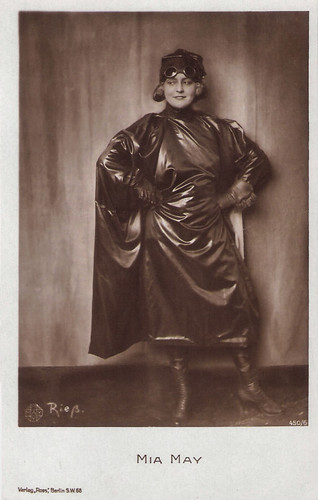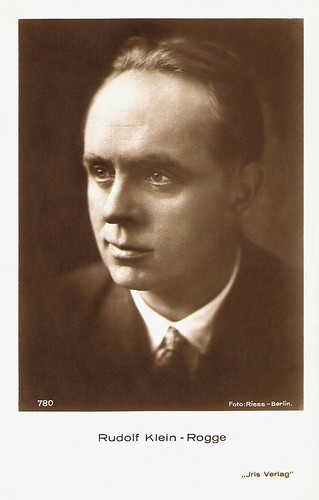
Mia May. German postcard by Ross Verlag, no. 450/5, 1919-1924. Photo: May-Film / Riess. Possibly for Die Herrin der Welt/The Mistress of the World (Joe May a.o., 1919).

Mia May. German postcard by Ross Verlag, no. 450/6, 1919-1924. Photo: May Film / Riess. Possibly for Die Herrin der Welt/The Mistress of the World (Joe May a.o., 1919).

Liane Haid. German postcard by Ross Verlag, Berlin, no. 462/2, 1919-1924. Photo: Riess.

Harry Liedtke. German postcard by Ross Verlag, no. 463/1, 1919-1924. Photo: Riess.

Bartolomeo Pagano aka Maciste. German postcard by Ross Verlag, no. 478/1, 1919-1924. Photo: Riess.

Bartolomeo Pagano aka Maciste. German postcard by Ross Verlag, no. 478/2, 1919-1924. Photo: Riess.
An exclusive meeting place for Berlin celebrities
Frieda Riess was born in Czarnikau in the Western Prussian town of Czarnikau (now Carnkov in Poland) in the province of Poznán where her German-Jewish parents were shopkeepers.
At the end of the 1890s, the family moved to Berlin where she first studied sculpture under Hugo Lederer (c. 1907) and later photography at the Berlin 'Photographischen Lehranstalt' of the Lette Verein (she later inspired photographer Marianne Breslauer to enroll there too). Riess received her diploma in the summer of 1915.
In 1918, she opened a studio (in German: atelier) on the prestigious Kurfürstendamm. It became one of the most popular studios in the city. Partly as a result of her marriage to the poet and journalist Rudolf Leonhard in the early 1920s, her social connections extended through Berlin’s art world of the 1920s. Her studio became an exclusive meeting place at exhibition openings.
Her clientele included such celebrities as playwright Walter Hasenclever, novelist Gerhart Hauptmann and actors and actresses including Tilla Durieux, Asta Nielsen, Mia May, and her daughter Eva May, and Emil Jannings. In addition, she contributed to the journals and magazines of the day including Die Dame, Berliner Illustrierte Zeitung, Der Weltspiegel, Querschnit and Koralle.
Like her colleagues Hugo Erfurth, Madame D´Ora, Lotte Jacobi, and Edward Steichen, Riess became a master of the advanced art of portraiture. The solo exhibition of 177 portraits in Alfred Flechtheim’s gallery in 1925 played a decisive part in this appreciation of the photographer. Flechtheim was one of the leading collectors and dealers in modern art during the 1920s. At that time it was somewhat surprising for one of Berlin’s leading art dealers to show photographs and the fact that he refers to photography as art invited particular attention.
Riess travelled to Paris, London, and Rome, where she moved in similar literary and aristocratic circles. While on a trip to Italy in 1929, she was invited to photograph Benito Mussolini.
Why she doesn’t rate a mention in histories of German photography until recently? Part of that was through her design. Since 1930 Frieda Riess had a liaison with the elderly French ambassador to Berlin, Pierre de Margerie. In 1932, they married and moved to Paris. She retreated from photography and Berlin society. She disappeared from the public eye.
From 1940 to 1945, she survived the German occupation of Paris in seclusion and died there in the mid-1950s. The date of her death cannot be clearly established and her place of burial remains unknown.
In 2008, a retrospective of the work of Frieda Riess was held in the Berlinische Galerie. That year the book 'Die Riess: fotografisches Atelier und Salon in Berlin 1918-1932' was publised, edited by Marion Beckers and Elisabeth Moortgat for Das Verborgene Museum.

Eva May. German postcard by Ross Verlag, no. 563/1, 1919-1924. Photo: Atelier Riess.

Maria Jacobini. German postcard by Ross Verlag, Berlin, no. 569/1, 1919-1924. Photo: Atelier Riess, Berlin.

Maria Jacobini. German postcard by Ross Verlag, Berlin, no. 569/2, 1919-1924. Photo: Atelier Riess, Berlin.

Liane Haid. German postcard by Ross Verlag, no. 1023/1, 1927-1928. Photo: Riess, Berlin.

Bernhard Goetzke. German postcard by Ross Verlag, no. 1279/1, 1927-1928. Photo: Riess.

Rudolf Klein-Rogge. Austrian postcard by Iris Verlag no. 780. Photo: Riess, Berlin.
Sources: Kraftgenie (Weimar), One Man's Treasure, and Wikipedia.
This post was last updated on 11 August 2021.
No comments:
Post a Comment